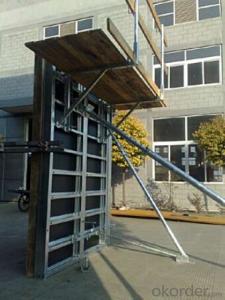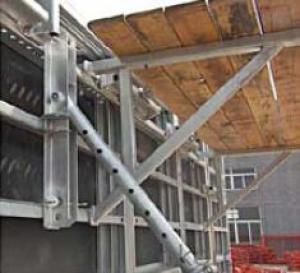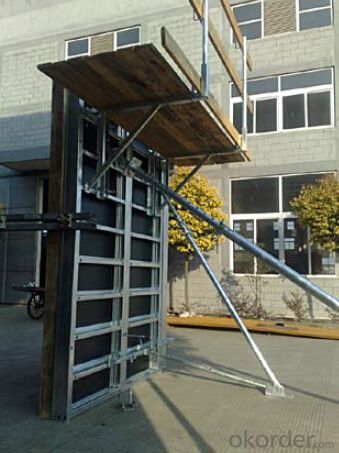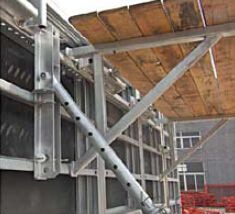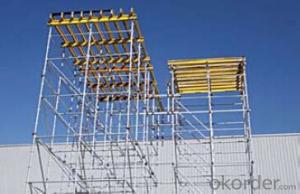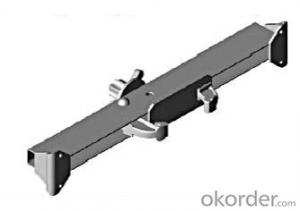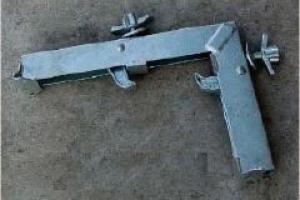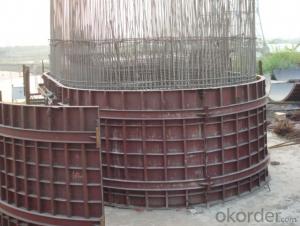Steel Frame working platformfor Formwork and Scaffolding system
- Loading Port:
- Tianjin
- Payment Terms:
- TT OR LC
- Min Order Qty:
- 50 m²
- Supply Capability:
- 1000 m²/month
OKorder Service Pledge
OKorder Financial Service
You Might Also Like
Steel-frame Formwork SF-140
Characteristics:
◆ Few parts for fast forming.
◆ Max. Concrete pressure: 80KN/m2.
◆ Hot-dip galvanized steel frame.
◆ The thickness of plywood is 18mm & the panel is 14cm.
◆ Compatibility with Hunnebeck Manto system due to similar edge profile.
System Details & Application:
◆ Neat joint and fast assembling with aligning panel clamp.
◆ Flexible panel arrangement and height extension.
◆ The selection of panels.
◆ Kinds of panel connectors.
◆ Corner clamp application.
◆ Length adjustment application.
◆ Height adjustment & aligning strut.
◆ Walkway bracket & platform.
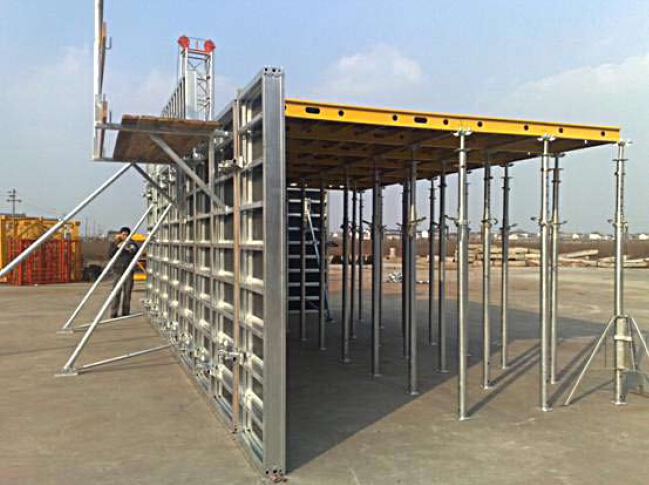
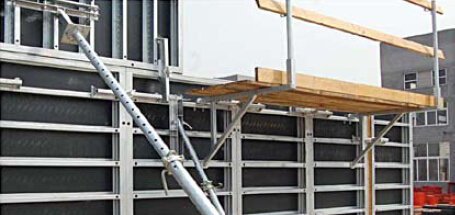
- Q: What are the safety considerations when using steel formwork?
- When using steel formwork, there are several safety considerations that need to be taken into account. Firstly, it is important to ensure that the formwork is properly installed and secured to prevent any collapses or accidents. Regular inspections should be conducted to check for any signs of wear or damage that could compromise its stability. Another safety consideration is the proper handling and storage of steel formwork. It can be heavy and cumbersome, so workers should be trained in proper lifting techniques to avoid strains or injuries. Adequate storage facilities should be provided to prevent any damage or tripping hazards. Additionally, when working with steel formwork, workers should wear appropriate personal protective equipment (PPE) such as helmets, gloves, and safety boots to protect themselves from any potential hazards or falling debris. They should also be trained in safe work practices, including proper use of tools and equipment, as well as the correct procedures for dismantling the formwork after use. Overall, by following these safety considerations, the risks associated with using steel formwork can be minimized, ensuring a safe working environment for all involved.
- Q: Can steel formwork be used for different types of concrete finishes?
- Indeed, various concrete finishes can be achieved through the utilization of steel formwork. With its remarkable versatility, steel formwork has the capability to be tailored in order to produce an array of concrete finishes such as sleek, textured, or patterned surfaces. By employing steel formwork, one can achieve precision in shaping and molding the concrete, thereby facilitating the creation of diverse finishes in accordance with the desired design and aesthetic specifications. Moreover, steel formwork can be effortlessly adapted and employed for different undertakings, rendering it a cost-efficient selection for attaining a wide range of concrete finishes.
- Q: Are all steel plates used for beam slab prefabrication
- If all steel plates are used for precast beam and slab, the shape of prefabricated components should be adopted
- Q: What are the different types of steel used in formwork construction?
- There are several types of steel used in formwork construction, each with their own specific characteristics and applications. 1. Mild Steel: This is the most commonly used type of steel in formwork construction. It is affordable, readily available, and easy to work with. Mild steel is suitable for most formwork applications and offers good strength and durability. 2. High Tensile Steel: This type of steel is stronger than mild steel and has a higher tensile strength, making it ideal for heavy-duty formwork structures. High tensile steel provides enhanced resistance to bending and deformation under heavy loads, making it suitable for large-scale construction projects. 3. Reinforcing Steel: Reinforcing steel, also known as rebar, is used in formwork construction to reinforce concrete structures. It is typically made of carbon steel and is available in various grades and sizes. Reinforcing steel is used to increase the tensile strength of concrete and improve its resistance to cracking and structural failure. 4. Stainless Steel: Stainless steel is used in formwork construction when corrosion resistance is a primary concern. It is particularly suitable for formwork exposed to harsh environmental conditions or in contact with corrosive materials. Stainless steel offers excellent resistance to corrosion, making it a durable and long-lasting option for formwork construction. 5. Alloy Steel: Alloy steel is a type of steel that is mixed with other elements to enhance its properties. It is commonly used in formwork construction for its high strength, toughness, and resistance to wear and tear. Alloy steel can withstand heavy loads and is often used in formwork systems that require superior performance and durability. Overall, the choice of steel used in formwork construction depends on the specific requirements of the project, including load-bearing capacity, durability, and resistance to corrosion. It is important to select the appropriate type of steel to ensure the safety and longevity of the formwork structure.
- Q: How does steel formwork handle different concrete pumping methods?
- Steel formwork is a versatile and durable solution for handling different concrete pumping methods. It is designed to withstand the pressure and force exerted during the pumping process, making it suitable for various pumping techniques. One common concrete pumping method is the use of boom pumps, which involves a flexible or telescopic boom that extends to reach the desired location. Steel formwork can easily accommodate this method as it provides a stable and secure surface for the boom pump to rest on. The strong and rigid nature of steel ensures that the formwork remains intact and can withstand the weight and vibrations generated by the pumping process. Another popular pumping method is line pumping, which utilizes a series of pipes and hoses to transport concrete to the desired location. Steel formwork is compatible with this method as well, as the pipes and hoses can be easily secured to the formwork using clamps or brackets. The formwork acts as a support system for the pipes, ensuring that they remain in place and can effectively transport the concrete without any disruptions. Additionally, steel formwork can handle other concrete pumping methods such as trailer-mounted pumps or truck-mounted pumps. These methods involve the use of a portable pump that can be moved to different locations. Steel formwork can be easily repositioned or adjusted to accommodate the pump, providing a stable and reliable platform for the pumping process. Overall, steel formwork is a suitable choice for handling different concrete pumping methods due to its strength, stability, and adaptability. It can effectively support the equipment used in various pumping techniques, ensuring a smooth and efficient concrete placement process.
- Q: How does steel formwork handle different concrete jointing techniques?
- Steel formwork is a versatile and robust system that can easily handle different concrete jointing techniques. Whether it is traditional jointing methods or modern techniques, steel formwork provides the necessary structural support and flexibility to accommodate various jointing requirements. For traditional jointing techniques such as construction or control joints, steel formwork allows for precise and clean cuts to be made in the concrete. The formwork acts as a guide, ensuring that the joints are accurately placed and aligned. The steel formwork's rigid structure provides stability during the concrete pouring process, preventing any misalignment or movement that could affect the jointing. In the case of modern jointing techniques like expansion joints, steel formwork can be adjusted to accommodate the desired joint spacing and movement. The formwork can be designed with additional features such as flexible connections or removable sections, allowing for the required expansion or contraction of the concrete. This ensures that the joints remain intact and functional, even when the concrete undergoes temperature or moisture-related changes. Additionally, steel formwork offers the advantage of reusable panels and components. This means that the formwork can be easily disassembled and reassembled to accommodate different jointing techniques or even reused for future projects. This flexibility and adaptability make steel formwork a cost-effective and efficient choice for handling various concrete jointing techniques. In conclusion, steel formwork is well-suited to handle different concrete jointing techniques. Its strength, stability, and adjustability allow for precise and accurate joint placement, while its reusability makes it a practical choice for various projects.
- Q: Can steel formwork be used for swimming pool construction?
- Yes, steel formwork can be used for swimming pool construction. Steel formwork offers durability and strength, making it suitable for creating the required concrete structure of a swimming pool. It is commonly used in the construction industry for various applications, including swimming pool construction.
- Q: How does steel formwork affect the overall weight of the structure?
- Steel formwork can have a significant impact on the overall weight of a structure. Compared to traditional timber formwork, steel formwork is generally heavier due to the inherent properties of steel. Steel is denser and heavier than wood, which means that steel formwork will contribute more to the overall weight of the structure. However, the weight of the steel formwork can also be advantageous in certain situations. The increased weight of steel formwork can provide stability and rigidity to the structure during the construction process, ensuring that the concrete is properly supported and shaped. This can lead to a more precise and durable final structure. Moreover, steel formwork is typically more durable and can be reused multiple times, whereas timber formwork often needs to be replaced after a few uses. This can result in a reduced environmental impact and cost savings in the long run, even though steel formwork may initially add more weight to the structure. Ultimately, the effect of steel formwork on the overall weight of a structure depends on various factors such as the size and complexity of the project, the specific design requirements, and the construction method chosen. However, it is important to consider the trade-offs between the weight of the formwork and its benefits in terms of stability, durability, and cost-effectiveness.
- Q: Can steel formwork be custom-made?
- Indeed, the option of customizing steel formwork exists. Steel, being an adaptable material, can be effortlessly molded and joined together through welding to produce formwork tailored to suit specific project demands. In situations where conventional formwork systems may prove inadequate due to distinctive design components or intricate geometries, the utilization of custom-made steel formwork is frequently favored in construction endeavors. The customization of steel formwork allows construction firms to ensure a perfect fit, thereby facilitating efficient and precise pouring of concrete, minimizing waste, and preserving time and financial resources. Moreover, the durability and reusability of custom-made steel formwork offer enduring advantages for numerous construction projects in the long run.
- Q: Can steel formwork be used for projects with high concrete durability demands?
- Yes, steel formwork can be used for projects with high concrete durability demands. Steel formwork is known for its strength, durability, and longevity, making it suitable for demanding construction projects. It can withstand heavy loads and provide the necessary support for the concrete during the curing process. Steel formwork also offers excellent dimensional stability, ensuring the accuracy and consistency of the concrete structure. Additionally, steel formwork can be reused multiple times, reducing waste and project costs. However, it is important to ensure proper maintenance and corrosion protection of the steel formwork to maximize its durability and ensure long-term performance.
Send your message to us
Steel Frame working platformfor Formwork and Scaffolding system
- Loading Port:
- Tianjin
- Payment Terms:
- TT OR LC
- Min Order Qty:
- 50 m²
- Supply Capability:
- 1000 m²/month
OKorder Service Pledge
OKorder Financial Service
Similar products
Hot products
Hot Searches
Related keywords
